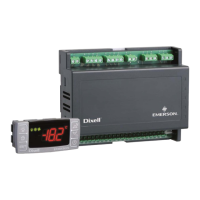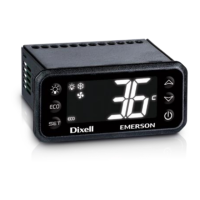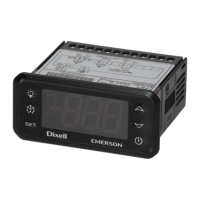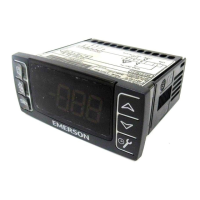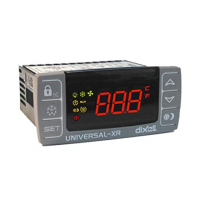End
Parameters have been correctly
transferred.
14.1 ALLARM RECOVERY
Probe alarms P1, P2, P3 and P4 start some seconds after the fault in the related probe;
they automatically stop some seconds after the probe restarts normal operation. Check
connections before replacing the probe.
Temperature alarms HA, LA, HA2 and LA2 automatically stop as soon as the
temperature returns to normal values.
Alarms EA and CA (with i1F = bAL) recover as soon as the digital input is disabled.
Alarm CA (with i1F = PAL) recovers only by switching off and on the instrument.
15. USE OF THE PROGRAMMING HOT-KEY
The XM units can UPLOAD or DOW NLOAD the parameter list from its own E2 internal
memory to the HOT-KEY and vice-versa through a TTL connector. Using HOT-KEY
the Adr will not changed.
15.1 DOWNLOAD (FROM THE HOT-KEY TO THE INSTRUMENT)
1. Turn OFF the instrument by means of the ON/OFF key, insert the HOT-KEY and
then turn the unit ON.
2. Automatically the parameter list of the HOT-KEY is downloaded into the
controller memory: the doL message is blinking. After 10 seconds the instrument
will restart working with the new parameters. At the end of the data transfer phase
the instrument displays the following messages: End for right programming. The
instrument starts regularly with the new programming. Err for failed
programming. In this case turn the unit off and then on if you want to restart the
download again or remove the HOT-KEY to abort the operation.
15.2 UPLOAD (FROM THE INSTRUMENT TO THE HOT-KEY)
1. When the XM unit is ON, insert the HOT-KEY and push “UP” key
2. The UPLOAD begins; the uPL message is blinking.
3. Remove the HOT-KEY. At the end of the data transfer phase the instrument
displays the following messages:
End = right programming;
Err = failed programming. In this case push SET key if you want to restart the
programming again or remove the not programmed HOT-KEY.
16. CONTROLLING LOADS
16.1 THE COOLING OUTPUT
The regulation is performed according to the temperature measured by the thermostat
probe that can be physical probe or virtual probe obtained by a weighted average
between two probes following the formula:
value_for_room_regulation = (rPA*rPE + rPb*(100-rPE))/100
If the temperature increases and reaches set point plus differential the solenoid valve
is opened and then it is closed when the temperature reaches the set point value again.
In case of fault in the thermostat probe the opening and closing time of solenoid valve
is configured by Con and CoF parameters.
16.2 STANDARD REGULATION AND CONTINUOUS REGULATION
The temperature regulation can be performed in three ways: the goal of the first way
(standard regulation) is reaching the best superheat via a classic temperature
regulation obtained using hysteresis. The second way permits to use the valve to
realize an high performance temperature regulation with a good factor of superheat
precision. This second possibility, it can be used only in centralized plants and it
is available only with electronic expansion valve by selecting [CrE = Y] parameter.
The third kind of regulation has been thought to be used with vales called evaporator
valves [CrE = EUP], in this configuration the valve is placed at the end of the
evaporator. In any case, the regulation is performed via PI regulator that gives the
opening percentage to the valve.
Standard regulation: [CrE = n]
In this case, the HY parameter is the differential for standard ON/OFF regulation. In
this case the int parameter is neglected.
Continuous regulation: [CrE = Y]
In this case, the HY parameter is the proportional band of PI in charge of room
temperature regulation and we advise to used at least [HY = 6.0°C/12°F]. The int
parameter is the integral time of the same PI regulator. Increasing int parameter the
PI regulator become slowly in reaction and of course is true vice versa. To disable the
integral part of regulation you should set [int = 0].
Evaporator valves: [CrE = EUP]
In this case, the system performs a regulation of the temperature without taking in
consideration the superheat (in fact the valve is at the end of the evaporator). The HY
parameter is the proportional band for the temperature regulation and int is the integral
time for the regulation.
The proportional action is performed only when the compressor relay is on.
In this situation there is no superheat regulation.
16.3 DEFROST
Defrost starting
In any case, the device check the temperature read by configured defrost probe
before starting defrost procedure, after that:
- (If RTC is present)Two defrost modes are available through the tdF parameter:
defrost with electrical heater and hot gas defrost. The defrost interval is controlled
by parameter EdF: (EdF = rtC) defrost is made in real time depending on the hours
set in the parameters Ld1 to Ld6 in workdays and in Sd1 to Sd6 on holidays; (EdF
= in) the defrost is made every IdF time.
- Defrost cycle starting can be operated locally (manual activation by means of the
keyboard or digital input or end of interval time) or the command can come from the
Master defrost unit of the LAN. In this case the controller will operate the defrost
cycle following the parameters it has programmed but, at the end of the drip time,
will wait that all the other controllers of the LAN finish their defrost cycle before to re-
start the normal regulation of the temperature according to dEM parameter.
- Every time any of the controller of the LAN begin a defrost cycle it issue the
command into the network making all the other controllers start their own cycle. This
allows a perfect synchronization of the defrost in the whole multiplexed cabinet
according to LMd parameter.
Defrost ending
- When defrost is started via rtC, the maximum duration of defrost is obtained from
Md parameter and the defrost end temperature is obtained from dtE parameter
- If dPA is present and [d2P = Y], the instrument stops the defrost procedure when
dPA is higher than dtE temperature.
At the end of defrost the drip time is controlled through the Fdt parameter.
16.4 FANS
CONTROL WITH RELAY
The fan control mode is selected by means of the FnC parameter:
C-n = running with the solenoid valve, OFF during the defrost;
C-Y = running with th1e solenoid valve, ON during the defrost;
O-n = continuous mode, OFF during the defrost;
O-Y = continuous mode, ON during the defrost.
An additional parameter FSt provides the setting of temperature, detected by the
evaporator probe, above which the fans are always OFF. This can be used to make
sure circulation of air only if his temperature is lower than set in FSt.
CONTROL WITH ANALOG OUTPUT (if present)

